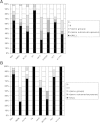Epidemiologic studies of modifiable factors associated with cognition and dementia: systematic review and meta-analysis
- PMID: 24962204
- PMCID: PMC4099157
- DOI: 10.1186/1471-2458-14-643
Epidemiologic studies of modifiable factors associated with cognition and dementia: systematic review and meta-analysis
Abstract
Background: Cognitive impairment, including dementia, is a major health concern with the increasing aging population. Preventive measures to delay cognitive decline are of utmost importance. Alzheimer's disease (AD) is the most frequent cause of dementia, increasing in prevalence from <1% below the age of 60 years to >40% above 85 years of age.
Methods: We systematically reviewed selected modifiable factors such as education, smoking, alcohol, physical activity, caffeine, antioxidants, homocysteine (Hcy), n-3 fatty acids that were studied in relation to various cognitive health outcomes, including incident AD. We searched MEDLINE for published literature (January 1990 through October 2012), including cross-sectional and cohort studies (sample sizes > 300). Analyses compared study finding consistency across factors, study designs and study-level characteristics. Selecting studies of incident AD, our meta-analysis estimated pooled risk ratios (RR), population attributable risk percent (PAR%) and assessed publication bias.
Results: In total, 247 studies were retrieved for systematic review. Consistency analysis for each risk factor suggested positive findings ranging from ~38.9% for caffeine to ~89% for physical activity. Education also had a significantly higher propensity for "a positive finding" compared to caffeine, smoking and antioxidant-related studies. Meta-analysis of 31 studies with incident AD yielded pooled RR for low education (RR = 1.99; 95% CI: 1.30-3.04), high Hcy (RR = 1.93; 95% CI: 1.50-2.49), and current/ever smoking status (RR = 1.37; 95% CI: 1.23-1.52) while indicating protective effects of higher physical activity and n-3 fatty acids. Estimated PAR% were particularly high for physical activity (PAR% = 31.9; 95% CI: 22.7-41.2) and smoking (PAR% = 31.09%; 95% CI: 17.9-44.3). Overall, no significant publication bias was found.
Conclusions: Higher Hcy levels, lower educational attainment, and decreased physical activity were particularly strong predictors of incident AD. Further studies are needed to support other potential modifiable protective factors, such as caffeine.
Figures



Similar articles
-
Pharmacotherapies for sleep disturbances in dementia.Cochrane Database Syst Rev. 2016 Nov 16;11(11):CD009178. doi: 10.1002/14651858.CD009178.pub3. Cochrane Database Syst Rev. 2016. Update in: Cochrane Database Syst Rev. 2020 Nov 15;11:CD009178. doi: 10.1002/14651858.CD009178.pub4. PMID: 27851868 Free PMC article. Updated.
-
Vitamin E for Alzheimer's dementia and mild cognitive impairment.Cochrane Database Syst Rev. 2017 Apr 18;4(4):CD002854. doi: 10.1002/14651858.CD002854.pub5. Cochrane Database Syst Rev. 2017. PMID: 28418065 Free PMC article.
-
Pharmacotherapies for sleep disturbances in Alzheimer's disease.Cochrane Database Syst Rev. 2014 Mar 21;(3):CD009178. doi: 10.1002/14651858.CD009178.pub2. Cochrane Database Syst Rev. 2014. Update in: Cochrane Database Syst Rev. 2016 Nov 16;11:CD009178. doi: 10.1002/14651858.CD009178.pub3. PMID: 24659320 Updated.
-
Vitamin E for Alzheimer's dementia and mild cognitive impairment.Cochrane Database Syst Rev. 2017 Jan 27;1(1):CD002854. doi: 10.1002/14651858.CD002854.pub4. Cochrane Database Syst Rev. 2017. Update in: Cochrane Database Syst Rev. 2017 Apr 18;4:CD002854. doi: 10.1002/14651858.CD002854.pub5. PMID: 28128435 Free PMC article. Updated.
-
Omega-3 fatty acids for the treatment of dementia.Cochrane Database Syst Rev. 2016 Apr 11;4(4):CD009002. doi: 10.1002/14651858.CD009002.pub3. Cochrane Database Syst Rev. 2016. PMID: 27063583 Free PMC article.
Cited by
-
Dual-task interference is related to attentional level in healthy farmers: An observational study.Medicine (Baltimore). 2020 Jul 2;99(27):e20720. doi: 10.1097/MD.0000000000020720. Medicine (Baltimore). 2020. PMID: 32629646 Free PMC article.
-
Does selective survival before study enrolment attenuate estimated effects of education on rate of cognitive decline in older adults? A simulation approach for quantifying survival bias in life course epidemiology.Int J Epidemiol. 2018 Oct 1;47(5):1507-1517. doi: 10.1093/ije/dyy124. Int J Epidemiol. 2018. PMID: 30010793 Free PMC article.
-
The Roles of Long-Term Hyperhomocysteinemia and Micronutrient Supplementation in the AppNL-G-F Model of Alzheimer's Disease.Front Aging Neurosci. 2022 Apr 26;14:876826. doi: 10.3389/fnagi.2022.876826. eCollection 2022. Front Aging Neurosci. 2022. PMID: 35572151 Free PMC article.
-
Predictive factors for Alzheimer's disease progression: a comprehensive retrospective analysis of 3,553 cases with 211 months follow-up.Front Neurol. 2023 Aug 24;14:1239995. doi: 10.3389/fneur.2023.1239995. eCollection 2023. Front Neurol. 2023. PMID: 37693748 Free PMC article.
-
Income, wealth, and Black-White disparities in cognition.Soc Sci Med. 2022 Oct;310:115298. doi: 10.1016/j.socscimed.2022.115298. Epub 2022 Aug 18. Soc Sci Med. 2022. PMID: 36007357 Free PMC article.
References
-
- de Champlain J, Wu R, Girouard H, Karas M, ELM A, Laplante MA, Wu L. Oxidative stress in hypertension. Clin Exp Hypertens. 2004;26:593–601. - PubMed
-
- Verhaeghen P, Salthouse TA. Meta-analyses of age-cognition relations in adulthood: estimates of linear and nonlinear age effects and structural models. Psychol Bull. 1997;122:231–249. - PubMed
-
- Moritz DJ, Kasl SV, Berkman LF. Cognitive functioning and the incidence of limitations in activities of daily living in an elderly community sample. Am J Epidemiol. 1995;141:41–49. - PubMed
-
- Lobo A, Launer LJ, Fratiglioni L, Andersen K, Di Carlo A, Breteler MM, Copeland JR, Dartigues JF, Jagger C, Martinez-Lage J, Soininen H, Hofman A. Prevalence of dementia and major subtypes in Europe: a collaborative study of population-based cohorts. Neurologic Diseases in the Elderly Research Group. Neurology. 2000;54:S4–9. - PubMed
-
- Li G, Shen YC, Chen CH, Zhao YW, Li SR, Lu M. An epidemiological survey of age-related dementia in an urban area of Beijing. Acta Psychiatr Scand. 1989;79:557–563. - PubMed
Publication types
MeSH terms
Substances
Grants and funding
LinkOut - more resources
Full Text Sources
Other Literature Sources
Medical

